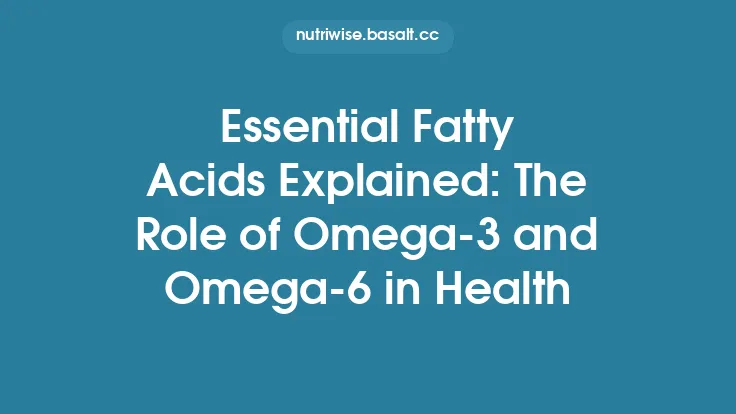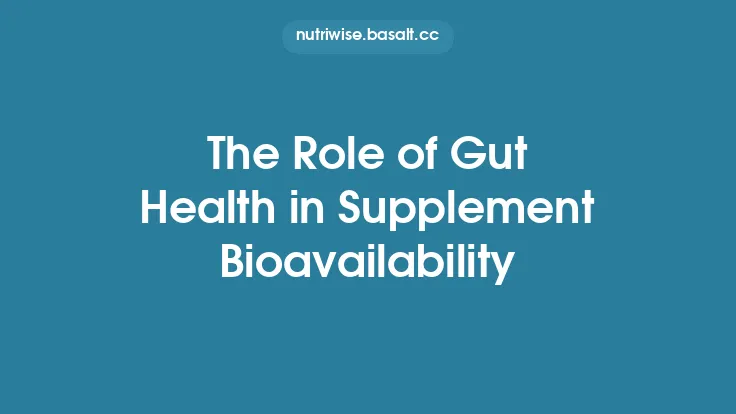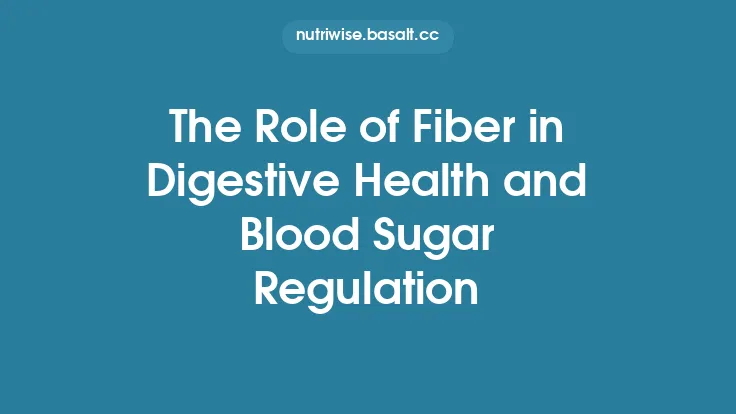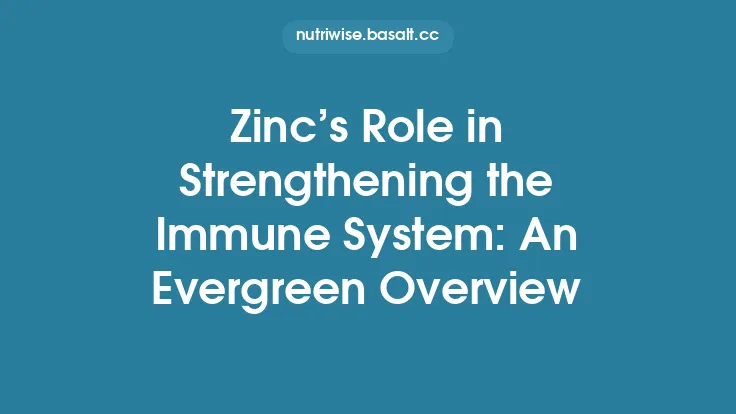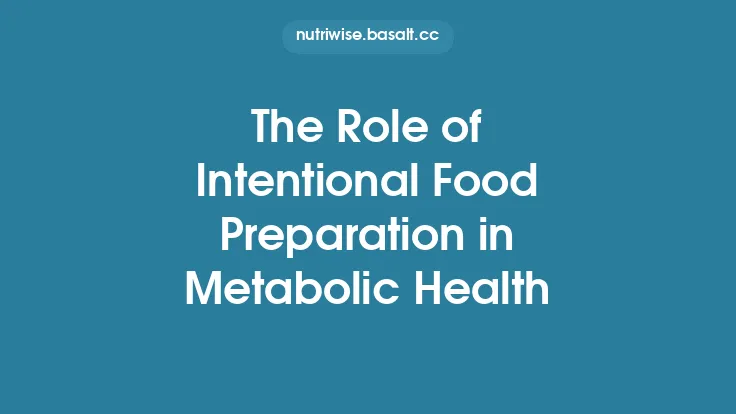Omega‑3 fatty acids have been the subject of intense scientific scrutiny for decades, largely because of their apparent ability to influence the health of the cardiovascular system. While the public discourse often emphasizes the “heart‑healthy” reputation of fish oil capsules, a rigorous appraisal of the evidence reveals a nuanced picture that balances modest benefits, specific patient contexts, and a well‑characterized safety profile. This overview synthesizes the mechanistic rationale, the most influential clinical trials, and the current consensus among professional societies, offering an evidence‑based perspective that can guide both clinicians and informed consumers.
Mechanistic Foundations of Cardiovascular Protection
The cardiovascular actions of omega‑3s are mediated through several interrelated pathways:
- Modulation of Eicosanoid Synthesis
Omega‑3s serve as substrates for the production of less‑inflammatory eicosanoids (e.g., prostaglandins, thromboxanes) compared with those derived from arachidonic acid. This shift attenuates endothelial activation and reduces leukocyte adhesion to the vascular wall.
- Resolution‑Phase Lipid Mediators
Specialized pro‑resolving mediators (SPMs) such as resolvins, protectins, and maresins are generated from omega‑3 precursors. SPMs actively terminate inflammation, promote clearance of cellular debris, and foster plaque stability.
- Membrane Fluidity and Ion Channel Function
Incorporation of long‑chain omega‑3s into cardiomyocyte phospholipid bilayers enhances membrane fluidity, which can influence the function of voltage‑gated ion channels. This effect is thought to underlie reductions in ventricular arrhythmia susceptibility.
- Endothelial Nitric Oxide Production
Omega‑3s up‑regulate endothelial nitric oxide synthase (eNOS) activity, leading to improved vasodilation and lower peripheral resistance, thereby contributing to modest blood‑pressure reductions.
- Triglyceride‑Lowering via Hepatic VLDL Secretion
By inhibiting hepatic diacylglycerol O‑acyltransferase (DGAT) and enhancing β‑oxidation, omega‑3s reduce very‑low‑density lipoprotein (VLDL) assembly and secretion, resulting in clinically meaningful reductions in fasting triglyceride concentrations.
These mechanisms collectively provide a biologically plausible basis for the observed cardiovascular outcomes in clinical research.
Key Clinical Evidence from Randomized Trials
Primary Prevention
- VITAL (Vitamin D and Omega‑3 Trial) – A large, double‑blind, placebo‑controlled study involving >25,000 participants without prior cardiovascular disease (CVD) examined 1 g/day of marine omega‑3s. Over a median follow‑up of 5.3 years, the primary composite endpoint (major cardiovascular events) was not significantly reduced (HR 0.96, 95 % CI 0.84–1.09). However, a prespecified analysis showed a modest 15 % relative risk reduction in myocardial infarction (MI) (HR 0.85, 95 % CI 0.73–0.99).
- REDUCE‑IT (Reduction of Cardiovascular Events with Icosapent Ethyl‑Intervention Trial) – Although this trial focused on a purified EPA formulation, its design and outcomes are instructive for the broader class. In patients with elevated triglycerides (≥150 mg/dL) on statin therapy, 2 g twice daily of icosapent ethyl reduced the composite of cardiovascular death, MI, stroke, coronary revascularization, or unstable angina by 25 % (HR 0.75, 95 % CI 0.68–0.83). The magnitude of benefit exceeded that expected from triglyceride lowering alone, suggesting additional anti‑inflammatory and plaque‑stabilizing effects.
Secondary Prevention
- GISSI‑Prevenzione – Conducted in the early 1990s, this trial enrolled post‑MI patients and assigned 1 g/day of omega‑3s versus placebo. After 3.5 years, the omega‑3 group experienced a 20 % relative reduction in all‑cause mortality (RR 0.80, 95 % CI 0.68–0.94) and a 15 % reduction in sudden cardiac death.
- OMEGA (Omega‑3 Trial in Post‑MI Patients) – A more recent, smaller trial (n≈3,800) using 1 g/day of omega‑3s did not demonstrate a statistically significant reduction in major adverse cardiovascular events (MACE) over 2 years. Subgroup analyses hinted at benefit in patients with low baseline omega‑3 index (<4 %), underscoring the importance of baseline status.
Heart Failure
- OMEGA‑HF – In patients with chronic heart failure with reduced ejection fraction, supplementation with 1 g/day of omega‑3s for 12 months did not significantly affect the primary endpoint of all‑cause mortality or cardiovascular hospitalization. Nonetheless, secondary analyses revealed improvements in functional capacity (6‑minute walk distance) and modest reductions in NT‑proBNP levels.
Atrial Fibrillation
- AF‑Omega – A meta‑analysis of three randomized trials (total n≈4,200) evaluating omega‑3 supplementation for primary prevention of atrial fibrillation (AF) after cardiac surgery found no significant effect on postoperative AF incidence (RR 0.96, 95 % CI 0.84–1.10). However, in patients with paroxysmal AF, a small pilot study suggested a reduction in AF burden with high‑dose EPA (4 g/day), warranting further investigation.
Meta‑Analyses and Systematic Reviews
Aggregating data across heterogeneous trials provides a broader perspective:
- Cochrane Review (2022) – Analyzing 79 randomized studies (≈112,000 participants), the review concluded that omega‑3 supplementation yields a modest absolute risk reduction of 0.5 % for coronary heart disease (CHD) events over 5 years, translating to a number needed to treat (NNT) of 200. The effect was more pronounced in trials using ≥2 g/day of EPA/DHA.
- JACC Meta‑Analysis (2023) – Focused on high‑risk secondary prevention cohorts, this analysis reported a 12 % relative risk reduction in composite cardiovascular outcomes with doses ≥2 g/day, with the greatest benefit observed in patients with elevated triglycerides (>200 mg/dL) and low baseline omega‑3 index.
- Blood Pressure Meta‑Analysis (2021) – Across 70 trials, omega‑3s lowered systolic blood pressure by an average of 1.5 mm Hg and diastolic pressure by 0.8 mm Hg. While clinically modest, these reductions may contribute cumulatively to cardiovascular risk mitigation.
Collectively, the evidence suggests that omega‑3s confer the most consistent benefit in secondary prevention settings, particularly among patients with dyslipidemia (high triglycerides) and those already receiving statin therapy.
Guideline Recommendations and Practical Dosage
Professional societies have integrated the evidence into nuanced recommendations:
| Organization | Population | Recommended Dose* | Key Comment |
|---|---|---|---|
| American Heart Association (AHA) | Patients with established CHD | 1 g EPA+DHA daily (preferably from fish) | Emphasizes dietary intake; supplements optional |
| European Society of Cardiology (ESC) | High‑risk patients with hypertriglyceridemia | 2–4 g EPA/DHA daily (prescription‑grade formulations) | Highlights triglyceride‑lowering as primary goal |
| American College of Cardiology (ACC)/AHA 2023 Guideline | Adults ≥45 y with elevated ASCVD risk | Consider 2 g EPA/DHA daily if triglycerides 150–500 mg/dL despite statin | Conditional recommendation (Level B) |
| National Lipid Association (NLA) | Patients on statins with residual triglyceride risk | 2–4 g EPA/DHA daily (prescription‑grade) | Supports use of EPA‑only products for additional risk reduction |
\*Doses refer to combined EPA + DHA unless otherwise specified. Prescription‑grade products (e.g., icosapent ethyl) are distinguished from over‑the‑counter (OTC) supplements due to higher purity and consistent EPA/DHA content.
Safety Profile and Potential Interactions
Omega‑3 supplementation is generally well tolerated, but clinicians should be aware of specific considerations:
- Bleeding Risk – High doses (>3 g/day) can modestly prolong bleeding time by inhibiting platelet aggregation. In patients on anticoagulants (warfarin, DOACs) or antiplatelet agents (aspirin, clopidogrel), routine monitoring of coagulation parameters is advisable, though large trials have not demonstrated a clinically significant increase in major bleeding events.
- Gastrointestinal Effects – Mild dyspepsia, fishy aftertaste, and loose stools are the most common adverse effects. Enteric‑coated formulations can mitigate these symptoms.
- Lipid Oxidation – Oxidized omega‑3s may exert pro‑inflammatory effects. Selecting products with verified antioxidant stabilization (e.g., vitamin E) and adhering to proper storage (cool, dark environment) reduces this risk, though detailed storage guidance is covered elsewhere.
- Drug Interactions – Omega‑3s may modestly increase the plasma concentration of certain antihypertensive agents (e.g., beta‑blockers) via altered membrane fluidity, but clinical relevance is minimal. No significant pharmacokinetic interactions have been identified with statins.
- Contraindications – Known hypersensitivity to fish or shellfish, severe hypertriglyceridemia requiring urgent medical therapy (e.g., plasmapheresis), and active bleeding disorders are relative contraindications for high‑dose supplementation.
Special Populations and Considerations
| Population | Evidence Summary | Practical Guidance |
|---|---|---|
| Elderly (≥75 y) | Trials such as VITAL included older adults and showed similar safety; modest benefit in MI reduction. | Use standard doses (1 g/day) unless triglycerides are markedly elevated; monitor for gastrointestinal tolerance. |
| Diabetes Mellitus | Meta‑analyses indicate no adverse effect on glycemic control; some data suggest improved endothelial function. | Standard dosing is appropriate; consider higher doses if triglycerides >200 mg/dL. |
| Chronic Kidney Disease (CKD) | Limited data; small RCTs suggest no impact on progression, but potential reduction in cardiovascular events. | Use caution at very high doses; monitor renal function if on concomitant nephrotoxic drugs. |
| Pregnancy & Lactation | Omega‑3s are essential for fetal neurodevelopment; cardiovascular data are indirect. | Recommended intake of 200–300 mg DHA daily (dietary sources preferred); supplementation safe at typical doses. |
| Patients on High‑Intensity Statins | Combination therapy (statin + omega‑3) in REDUCE‑IT demonstrated additive risk reduction. | Consider 2–4 g EPA/DHA daily if triglycerides remain >150 mg/dL despite statin. |
Emerging Research and Future Directions
- Genotype‑Guided Supplementation – Polymorphisms in the FADS1/2 genes influence endogenous conversion of shorter‑chain omega‑3s to EPA/DHA. Ongoing trials are evaluating whether genotype‑based dosing can personalize therapy.
- Novel Formulations – Lipid‑nanoparticle and emulsified omega‑3 preparations aim to improve bioavailability, especially in patients with malabsorption syndromes. Early pharmacokinetic data suggest up to 30 % higher plasma EPA/DHA levels compared with standard ethyl‑ester capsules.
- Omega‑3 Index as a Therapeutic Target – The omega‑3 index (percentage of EPA + DHA in red blood cell membranes) correlates with cardiovascular risk. Interventional studies are testing whether titrating supplementation to achieve an index ≥ 8 % yields superior outcomes versus fixed dosing.
- Combination with Anti‑Inflammatory Agents – Trials pairing omega‑3s with colchicine or IL‑1β inhibitors are exploring synergistic anti‑inflammatory effects on atherosclerotic plaque activity.
- Impact on Microbiome‑Mediated Metabolism – Recent metabolomic work suggests that gut microbiota modulate the conversion of omega‑3s into bioactive SPMs. Manipulating the microbiome may enhance cardiovascular benefits.
Practical Take‑aways for Clinicians and Informed Consumers
- Target the Right Patients – The most robust evidence supports omega‑3 supplementation in secondary prevention, especially for individuals with elevated triglycerides despite statin therapy.
- Dose Matters – Benefits on major cardiovascular events become more apparent at ≥2 g/day of EPA/DHA, often requiring prescription‑grade products to ensure dose accuracy.
- Assess Baseline Status – Measuring the omega‑3 index can identify patients who are deficient and may derive the greatest incremental benefit.
- Balance with Overall Diet – While supplementation can fill gaps, a diet rich in fatty fish (≥2 servings/week) remains the cornerstone of omega‑3 intake and confers additional nutrients (e.g., selenium, vitamin D).
- Monitor Safety – Routine evaluation of bleeding parameters is not required for standard doses, but clinicians should remain vigilant in patients on anticoagulants or with bleeding disorders.
- Stay Updated – The field is evolving rapidly, with genotype‑guided dosing and novel formulations on the horizon. Periodic review of emerging guidelines will ensure optimal patient care.
In summary, omega‑3 fatty acids occupy a modest yet meaningful niche in cardiovascular risk management. Their pleiotropic actions—ranging from triglyceride reduction to inflammation resolution—translate into measurable clinical benefits primarily in high‑risk, secondary‑prevention populations. When integrated thoughtfully with established therapies and individualized to patient characteristics, omega‑3 supplementation can be a valuable component of a comprehensive cardiovascular prevention strategy.
